Photoionization detection (PID) sensors are the first choice for monitoring exposure to toxic levels of VOCs. The sensor includes a lamp that acts as a high-energy ultraviolet light source. The lamp is encased in an inert gas, most commonly krypton, and electrodes. The energy of ultraviolet light excites a neutral charged VOC(volatile organic compound) molecule by removing an electron.

The energy required to remove an electron from a volatile organic compound molecule is called the ionization potential (IP). The larger the molecule, or the more double or triple bonds it contains, the lower its IP value. Therefore, in general, the larger or more fragile the molecule, the easier it is to detect.
This technique does not require the use of a sinter, which may prevent gas from reaching the sensor. It is also not easily toxic to chemicals or silicone found in cleaning products, although some cleaners containing large, fragile molecules can cause positive readings.
Benefits of PID technology
This technique can detect a large number of solvent types. Books have been written detailing PID cross-calibration responses to over 750 solvent and gas types at ppm concentrations. It does not require air to function, it is not affected by toxic substances, and it can produce small changes with moderate changes in temperature.

PID is very sensitive and will respond to many different volatile organic compounds. The magnitude of the response is proportional to the concentration of the gas. However, 50ppm of one gas will produce a different reading than 50ppm of the other. To solve this problem, the detector is usually calibrated to isobutene and then the correction factor is used to obtain an accurate reading of the target gas. Each gas has a different correction factor. Therefore, it is necessary to know the correct correction factor to be applied to the gas.
Therefore, particle sensors and photoionization detectors can be complementary technologies in many applications. The bottler is excellent at monitoring methane, propane and other common combustible gases at %LEL(lower explosive limit) levels. PID, on the other hand, can detect a large number of volatile organic compounds and hydrocarbon molecules that are actually undetectable by paper machine sensors, and of course, in the range of parts per million, toxic levels require alarm. Therefore, in many environments, the best approach is a multi-sensor instrument equipped with both technologies.
Factors and problems affecting PID technology
PID sensor technology is versatile and can be used to measure gaps during downtime in the chemical and petrochemical industries, monitor operations in silos and enclosed Spaces, detect leaks, and many other applications.

Insufficient sensor voltage can affect the function of the PID sensor, as well as extremely high humidity or particle density. Also, the lights have a lifespan of 2 years, but they don’t last 3 years, so the output must be monitored to check if it goes into a fault state.
The problems with this sensor are limited to age-related issues.
The lamp gets old and the voltage gets dusty
Some common gas types do not respond, such as methane and propane. The risk assessment needs to show that the expected gas type has a response. If this information is not a known gas type, then our website or customer support staff can help.
PID sensors are the most expensive sensors used in our products. They’re good, but they’re good quality and they cost a lot.
How do I know when something is wrong with the technology?
The results did not match the base values detected by our PID bearing products, causing our instruments to fail.
Our portable and stationary products are equipped with PID sensor that can detect large volatile organic compounds and hydrocarbon molecules that may be virtually undetectable by bottle sensors, certainly in the one part per million range that would need to alert toxic levels.
For more information, please visit our technical page.
